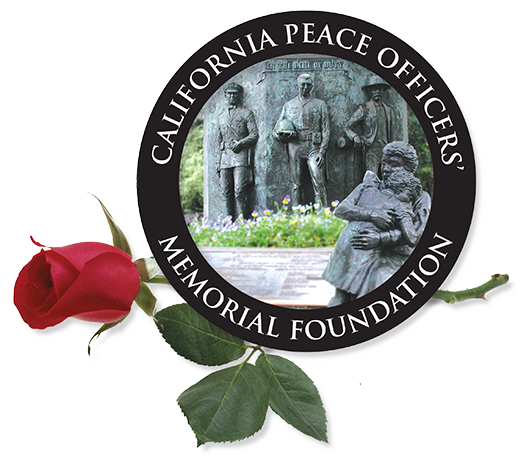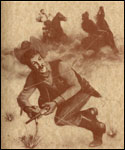On Jan. 23, newly appointed Los Angeles County Sheriff James Barton along with Deputies William H. Little, Charles K. Baker, Charles T. Daly and three others set out to capture the notorious Flores/Daniel gang.
Six times James R. Barton was elected Sheriff of Los Angeles County, serving five consecutive years (1851-55) with a one-year hiatus. Barton refused to run again after a vigilante group lynched his prisoner. Two other men tried unsuccessfully to fill his shoes before Barton took the reins once more. Crime was rampant in Los Angeles, averaging one violent death per day. Barton was intrepid. When informed that the notorious Flores/Daniel gang was looting and pillaging near San Juan Capistrano, he did not hesitate.
Barton had succeeded in arresting and convicting several of these gunmen, some of whom had been sent to San Quentin. Among these was Andres Fontes, who had been convicted of horse stealing and sentenced to two years in prison. It is said that, as Fontes was being placed on the stage to be transported north, he threatened Barton, saying, “When I return I’m going to kill you.” A few historians have speculated that Fontes’ resentment toward Barton was a personal matter, stemming from an attraction each had for the same woman.
Fontes served his term and was released. He came back and joined a gang of malcontents under the leadership of Juan Flores and Pancho Daniel. The latter was a notorious bandit who had served time in San Quentin, and, along with fourteen others, had escaped and joined forces with the gang led by Flores.
A vicious criminal, Flores himself had a long and cruel record. He had organized a band of the worst cutthroats and criminals ever to infest the Southland. When Flores and Daniel joined forces they became an extremely dangerous alliance, threatening to kill every “gringo” in their path.
On January 20, 1857, the gang rode into San Juan Capistrano. A short time later they murdered a storekeeper by the name of George W. Pflugardt as he was preparing his evening meal. After placing the victim’s body on the table, they sat down and ate what he had prepared for himself. At the same time members of the gang plundered other stores in town and terrorized the merchants. These outrages were typical of the many crimes this gang committed in the vicinity of the old mission town.
In Los Angeles, Sheriff Barton called for volunteers to accompany him to San Juan Capistrano to capture the outlaws. His posse consisted of seven men, including himself, and on the night of January 22, 1857, they left Los Angeles and rode south. The men who made up the posse were Sheriff Barton, William H. Little, Charles Baker, Charles F. Daly, Calvin Hardy, Frank Alexander and a man known only as Swartz.
Andres Fontes had remained in Los Angeles as a lookout for the gang and, learning of the sheriff’s plan, immediately rode straight to Capistrano and informed Flores and Daniel of the posse’s destination.
The posse stopped for breakfast at “Refugio,” the main house of the Rancho San Joaquin, which was southwest of the present city of Santa Ana. It was owned by one of California’s finest old Dons, Jose Sepulveda, described as “a princely character and genial host.”
Gathered about the Don’s adobe buildings were dozens of vaqueros and servants, Indians and Mexicans. Among these was Chola Martina, an Indian girl who happened to be the sweetheart of Flores.
Leaving their guns on a table in an outbuilding, the posse members sat down to breakfast. Don Jose warned Barton that Flores had a large force of fifty or sixty men who were well armed and mounted. He advised the Sheriff against going further, since the posse was so pitifully outnumbered.
Barton, however, insisted on continuing the pursuit, and immediately after breakfast he and his small posse resumed their quest.
The lawmen had traveled about twelve miles and were riding through a canyon when they were suddenly ambushed. A single horseman, who fled at the sight of them, caused Baker and Little to give chase.
They grabbed their guns to return fire, only to discover that someone had removed the ammunition from the weapons. To the outlaw gang, it was like shooting fish in a barrel. Twenty more men came out of hiding and slaughtered them. Seeing this, Barton and the others gave chase. Barton was shot through the heart, and the remaining deputies fled. Daly was overtaken and killed.
The three other deputies rode fast horses and were able to get away before the outlaws could organize a pursuit. The deputies decided to split up. Hardy rode to Los Angeles, Alexander made it to San Gabriel and Swartz headed for San Pedro.
It has been suspected, but never proven, that Flores’ girlfriend, Chola Martina, had removed the rounds from the guns of the posse while Barton and his men were having breakfast with Don Jose.
Within two hours after the facts became known in Los Angeles, a posse of approximately sixty men was organized by General Andres Pico. Another posse was formed and started immediately for San Juan Capistrano, under the leadership of James Thompson, who later became sheriff. A third posse was led by another future sheriff, J. Frank Burns, who at this time was Barton’s deputy in the San Gabriel district.
When Thompson’s posse arrived at the place of the ambush, they found what was left of Sheriff Barton and the three deputies. Their bodies had been mutilated and the remains scattered. Catching those responsible suddenly took on greater importance.
The killers were pursued into the mountains, and most of them were soon captured. General Pico was most efficient. He captured Silvas and Ardillero, two of the most noted of the gang, and hanged them on the spot. Fifty-two were arrested and lodged in the Los Angeles jail. Of these, eleven were hanged and the others were set free.
Juan Flores was condemned by popular vote and, on February 14, 1857, was hanged near the top of Fort Hill (present site of the Los Angels Board of Education). Virtually every person in town attended the execution. Flores was only 22 years old, and defiant to the end.
Pancho Daniel was captured on January 19, 1858, almost a year after the murders, near San Jose. The Santa Clara County sheriff found him hiding in a haystack. He had three trials, but through legal technicalities, managed to forestall conviction. A change of venue to Santa Barbara was eventually granted. On the morning of November 30, 1858, Daniel’s body was found hanging from a beam across the gateway of the jail yard.
Four of the outlaws were executed by the people of San Gabriel. Andres Fontes, who was supposed to have instigated the killing of Barton, escaped into Baja California, where he was later killed. Chico Contreras was the only one of the gang leaders who escaped execution. He was captured, made a full confession and was then deported to Mexico. More than a hundred of the gang members were either captured or killed in pursuit.
Sheriff Barton and Deputies Little, Baker and Daly became the first lawmen in Los Angeles County to lose their lives in the line of duty.

